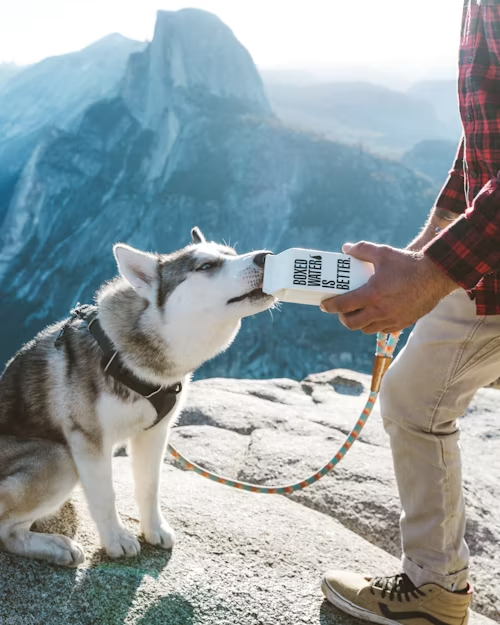Contents
Hiking with your dog is a fantastic way to explore the great outdoors, stay active, and bond with your furry friend. However, a successful hiking trip requires careful planning and packing. To ensure both you and your dog have a safe and enjoyable experience, here’s a comprehensive checklist of everything you need to bring along for your big day out.
1. Leash and Harness
- Why It’s Important: A sturdy leash and a well-fitted harness are essential for keeping your dog safe and under control on the trail. A harness distributes pressure more evenly, making it more comfortable for your dog, especially on longer hikes.
- Tips: Consider a hands-free leash that attaches to your waist for easier movement.
2. Dog Collar with ID Tags
- Why It’s Important: Ensure your dog’s collar is secure and includes up-to-date ID tags with your contact information. In case your dog gets separated from you, this will help ensure a swift reunion.
- Tips: Microchipping your dog adds an extra layer of security.
3. Portable Water Bowl and Water
- Why It’s Important: Hydration is crucial for both you and your dog, especially during strenuous hikes. A collapsible water bowl makes it easy to provide your dog with fresh water on the go.
- Tips: Bring more water than you think you’ll need, particularly on hot days or long trails.
4. Dog-Friendly Sunscreen
- Why It’s Important: Just like humans, dogs can get sunburned, especially on areas with less fur, such as their nose, ears, and belly. Use a dog-safe sunscreen to protect your pup from harmful UV rays.
- Tips: Apply sunscreen 30 minutes before heading out, and reapply as needed.
5. Dog Boots
- Why It’s Important: Dog boots protect your dog’s paws from rough terrain, hot surfaces, and cold conditions. They are particularly useful on rocky trails, in snowy conditions, or on hot sand.
- Tips: Get your dog used to wearing boots before your hike to avoid discomfort on the trail.
6. First-Aid Kit
- Why It’s Important: Accidents can happen, so it’s essential to carry a first-aid kit designed for dogs. Include items like bandages, antiseptic wipes, tweezers (for tick removal), and any necessary medications.
- Tips: Learn basic first-aid techniques for dogs, such as how to bandage a paw or remove a tick.
7. Dog Backpack
- Why It’s Important: If your dog is physically fit and used to wearing a backpack, they can help carry some of their own gear, such as water, food, and waste bags. This also helps to distribute weight evenly.
- Tips: Ensure the backpack is properly fitted and not too heavy—no more than 10-15% of your dog’s body weight.
8. Food and Treats
- Why It’s Important: Pack enough food for your dog’s needs, along with some high-energy treats to keep them fueled during the hike. Treats are also useful for training and rewarding good behavior on the trail.
- Tips: Opt for lightweight, non-perishable food options that are easy to carry.
9. Waste Bags
- Why It’s Important: Keeping the trail clean is essential for preserving nature and being respectful of other hikers. Always pack out your dog’s waste using biodegradable waste bags.
- Tips: Bring extra bags in case you run out or encounter other hikers who might need one.
10. Cooling Vest or Bandana
- Why It’s Important: On hot days, a cooling vest or bandana can help keep your dog’s body temperature down. These items are designed to retain moisture and provide cooling relief as they evaporate.
- Tips: Soak the vest or bandana in cold water before you start your hike for maximum effectiveness.
11. Navigation Tools
- Why It’s Important: While this is more for you, having a map, compass, or GPS device ensures you don’t get lost on unfamiliar trails. Knowing your route also helps you plan for your dog’s needs.
- Tips: Familiarize yourself with the trail and any potential hazards before you start your hike.
12. Dog Towel
- Why It’s Important: A quick-dry towel is handy for drying off your dog after swimming, crossing streams, or if they get caught in the rain. It also helps keep your car clean on the ride home.
- Tips: Choose a lightweight, compact towel that’s easy to pack.
13. Tick and Flea Protection
- Why It’s Important: Hiking trails can expose your dog to ticks and fleas, which can lead to serious health issues. Ensure your dog is protected with appropriate tick and flea preventatives.
- Tips: Check your dog for ticks after the hike, especially in areas like the ears, neck, and belly.
14. Extra Layer or Blanket
- Why It’s Important: Weather can change quickly, especially in mountainous areas. Bringing an extra layer or blanket for your dog can help keep them warm if temperatures drop.
- Tips: A lightweight, packable blanket or dog jacket is ideal for sudden temperature changes.
15. Emergency Contact Information
- Why It’s Important: In case of an emergency, have your veterinarian’s contact information and the location of the nearest emergency vet clinic saved on your phone. Also, inform someone of your hiking plans and expected return time.
- Tips: Carry a physical copy of your vet’s contact details in your first-aid kit.
16. Dog-Friendly Trail Guide or Map
- Why It’s Important: Not all trails are dog-friendly, so it’s essential to research and choose trails that allow dogs. A dog-friendly trail guide or map helps you find the best routes for your hike.
- Tips: Look for trails with features like streams or lakes where your dog can cool off.
17. Poop Scooper or Shovel
- Why It’s Important: In some areas, especially in the backcountry, it’s best to bury your dog’s waste. A small poop scooper or shovel can make this task easier and more environmentally friendly.
- Tips: Dig a hole at least 6 inches deep and 200 feet away from water sources to bury waste.
18. Insect Repellent for Dogs
- Why It’s Important: Protect your dog from mosquitoes, flies, and other insects with a dog-safe insect repellent. This helps prevent discomfort and reduces the risk of insect-borne diseases.
- Tips: Apply insect repellent to your dog before heading out, focusing on exposed areas like the ears and belly.
19. Reflective Gear
- Why It’s Important: If you’re hiking in low light or during dawn or dusk, reflective gear helps ensure your dog is visible to others. This is especially important if you’re near roads or busy trails.
- Tips: Consider a reflective leash, collar, or vest for added visibility.
20. Camera or Smartphone
- Why It’s Important: Capture the memories of your hiking adventure with your dog! Photos and videos of your journey will help you remember the fun and share it with friends and family.
- Tips: Keep your phone in a waterproof case to protect it from the elements.
Final Thoughts
Hiking with your dog is a rewarding experience that allows you both to enjoy the beauty of nature while getting some exercise. By following this checklist and being well-prepared, you can ensure that your hike is safe, enjoyable, and memorable for both you and your furry companion. So grab your gear, pick a trail, and embark on an adventure you and your dog will never forget!











Leave a Reply